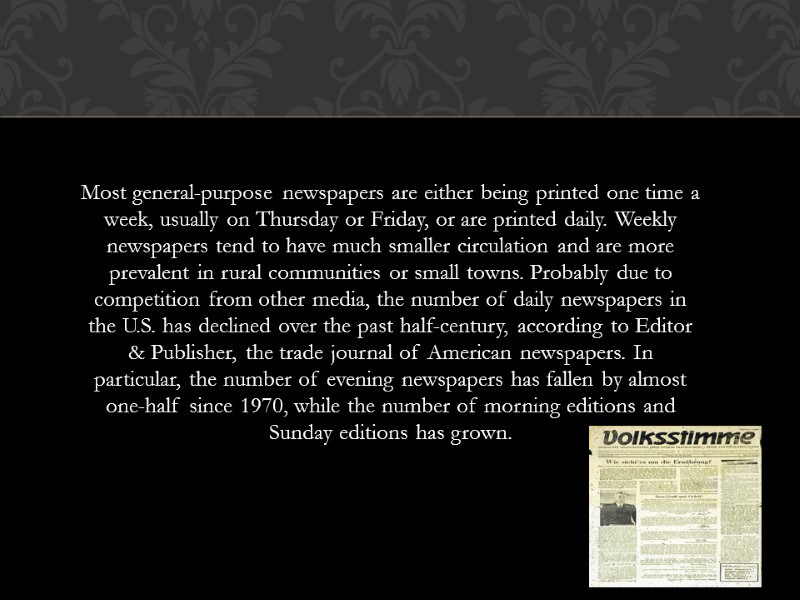Fulfilled: Julia Behovskaya Presentation topic: Media in the


Fulfilled: Julia Behovskaya Presentation topic: Media in the United States

Media of the United States consist of several different types of communications media: television, radio, cinema, newspapers, magazines, and Internet-based Web sites. The U.S. also has a strong music industry.

The organisation Reporters Without Borders compiles and publishes an annual ranking of countries based upon the organisation's assessment of their press freedom records. In 2011-12 United States was ranked 47th out of 179 countries, which was a setback from the preceding year.

American radio broadcasts in two bands: FM and AM. Talk radio as a political medium has also exploded in popularity during the 1990s, due to the 1987 repeal of the Fairness Doctrine, which meant that stations no longer had to "balance" their day by programming alternative points of view.The Federal Communications Commission (FCC)in 1970 had limited the number of radio station one person or company could own to 1 am and 1 FM locally and 7 am and 7 FM stations nationally. See IBOC and HD Radio. Radio

A new form of radio that is gaining popularity is satellite radio. Unlike terrestrial radio music channels are commercial free and other channels feature minimal commercials. Satellite radio also is not regulated by the FCC. Arbitron, a consumer research company, provides ratings (similar to the Nielsen ratings) for national and local radio stations in the United States. satellite radio

Ninety-nine percent of American households have at least one television and the majority of households have more than one. The four major broadcasters in the U.S. are the National Broadcasting Company (NBC), Columbia Broadcasting System (CBS), the American Broadcasting Company (ABC) and Fox. Public television has a far smaller role than in most other countries. Television

However, a number of states, including West Virginia, Maryland, Kentucky, and South Carolina, among others, do have state-owned public broadcasting authorities which operate and fund all public television stations in their respective states. The income received from the government is insufficient to cover expenses and stations also rely on corporate sponsorships and viewer contributions.

In the 20th century, the motion picture industry rose to become one of the most successful and powerful industries in the U.S. Along with other intellectual property industries, its relative importance to the American economy has strengthened as the importance of manufacturing and agriculture have decreased. Motion pictures

Publick Occurrences, Both Foreign and Domestick, the first newspaper published in America, was printed by Richard Pierce and edited by Benjamin Harris in Boston on September 25, 1690. first American newspapers

Newspapers have declined in their influence and penetration into American households over the years. The U.S. does not have a national paper. The New York Times and The Wall Street Journal are sold in most U.S. cities. Аll major metropolitan areas have their own local newspapers. Typically, a metropolitan area will support at most one or two major newspapers, with many smaller publications targeted towards particular audiences. Although the cost of publishing has increased over the years, the price of newspapers has generally remained low. Newspapers

Most general-purpose newspapers are either being printed one time a week, usually on Thursday or Friday, or are printed daily. Weekly newspapers tend to have much smaller circulation and are more prevalent in rural communities or small towns. Probably due to competition from other media, the number of daily newspapers in the U.S. has declined over the past half-century, according to Editor & Publisher, the trade journal of American newspapers. In particular, the number of evening newspapers has fallen by almost one-half since 1970, while the number of morning editions and Sunday editions has grown.

For comparison, in 1950, there were 1,772 daily papers (and 1,450 – or about 70 percent – of them were evening papers) while in 2000, there were 1,480 daily papers (and 766—or about half—of them were evening papers.) Daily newspaper circulation is also slowly declining in America, partly due to the near-demise of two-newspaper towns, as the weaker newspapers in most cities have folded: 1960 58.8 million 1970 62.1 million 1980 62.2 million 1990 62.3 million 2000 55.8 million

Thanks to the huge size of the English-speaking North American media market, the United States has a large magazine industry with hundreds of magazines serving almost every interest, as can be determined by glancing at any newsstand in any large American city. Most magazines are owned by one of the large media conglomerates or by one of their smaller regional brethren. Magazines

The U.S. has three leading weekly newsmagazines: Time, Newsweek and U.S. News and World Report. Time and Newsweek are center-left while U.S. News and World Report tends to be center-right. Time is well known for naming a "Person of the Year" each year, while U.S. News publishes annual ratings of American colleges and universities.

The Internet has provided a means for newspapers and other media organizations to deliver news and, significantly, the means to look up old news. Some organizations only make limited amounts of their output available for free, and charge for access to the rest. Other organizations allow their archives to be freely browsed. It is possible that the latter type obtain more influence, as they are true to the spirit of freedom of information by virtue of making it free. Internet

Anyone who has followed external links only to be confronted with a pay to view banner, might attest that the reputations of organizations that charge is not enhanced by their charging policy, particularly when the same information is available from sources that don't charge.

The Internet, by means of making available such constantly growing news archives, is, in effect, writing our history as it happens, at a level of detail never before known. While proprietary archives are slowly exposed to the public after many decades, organizations that maintain immediately updating resources have more control over what will be remembered by the general public in the near future.
11572-behovskaya_-_media_in_the_usa.ppt
- Количество слайдов: 17

